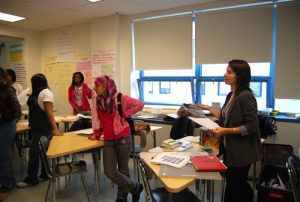Looking beyond objects and paintings, we explore how college teachers can use museum education practices of physicality, narrativity, and materiality to assess prior knowledge, spur interaction, and spark students’ retention in their classrooms.
Physicality pays special attention to space and movement.
Movement fuels interaction and aids comprehension.  Biology shows that increasing blood flow helps more oxygen to reach the brain, which enhances brain function. Reading about pleasure or pain can never substitute for experiencing it in one’s body. In the same way, by creating somatic learning experiences we offer our students additional access points to knowledge that can spark new forms of curiosity and offer opportunities for students to engage beyond verbal and written modes of communication.
Biology shows that increasing blood flow helps more oxygen to reach the brain, which enhances brain function. Reading about pleasure or pain can never substitute for experiencing it in one’s body. In the same way, by creating somatic learning experiences we offer our students additional access points to knowledge that can spark new forms of curiosity and offer opportunities for students to engage beyond verbal and written modes of communication.
Narrativity looks at story and story-telling as powerful tools for teaching and learning.
Storytelling and narrative can be utilized across the disciplines to generate empathy, make meaning, personalize, organize information, build community and strengthen connections between students’ personal experiences and course content. These concepts are intrinsically linked, but pedagogues have identified the important ways in which they differ. Storytelling focuses on the synthesis of many parts. Narrative examines the particular point of view or perspective from which a story is told.
Materiality explores meaning-making through objects and images.
Objects are central to museum interpretation, but seldom considered in the college classroom. Methods such as close looking, handling objects, and rummaging can help professors to be what Elizabeth Latham calls “object advocates” who “not only reveal many more layers of information, but will also provide opportunities…to project their own experiences onto objects,” and thereby connect with students at the material, personal, and socio-cultural levels.

